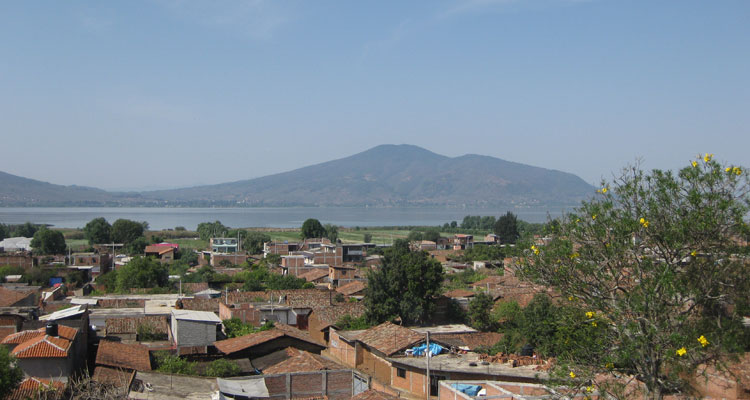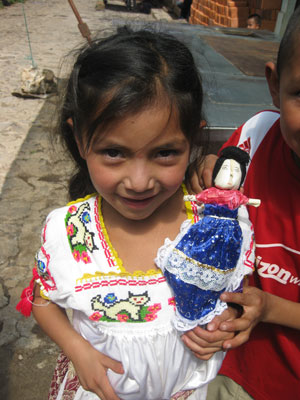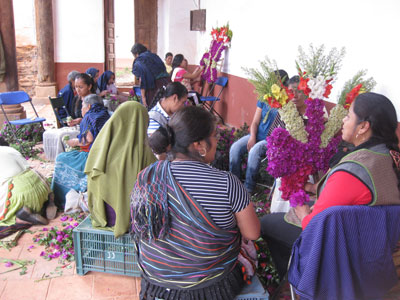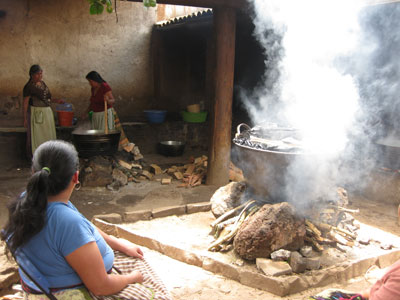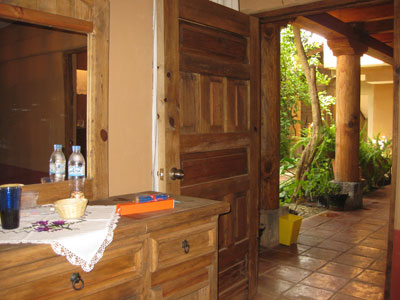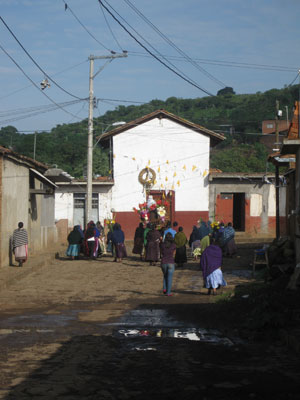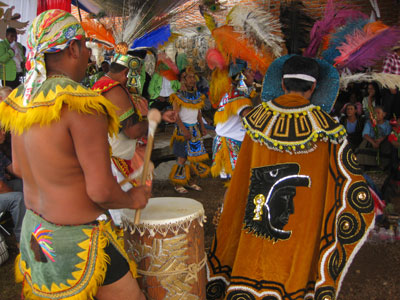Past meets present in the small Mexican village of Sante Fe de la Laguna
by Dorothy Aksamit; Sausalito, CA
Along the well-worn trail of sun-washed beaches awash in margaritas, I began my discovery of Mexico years ago, taking occasional day trips to nearby ancient ceremonial sites and visiting colonial Mexico, where fantasy cities reminiscent of old Spain had miraculously landed, often atop the old ceremonial centers. But on a visit in July ’10, my search was for obscure pueblos where daily life unfolds much as it has since the coming of the Spanish conquistadores in the 1500s.
The pueblos along the shores of Lake Pátzcuaro, located in the state of Michoacán, were my dream come true.
Planning a visit
The town of Pátzcuaro is only an hour away from the dazzling colonial city of Morelia. Although Pátzcuaro is not as grand, it still is endlessly interesting, with two plazas, impressive churches and constant street celebrations. It is also a magnet for Day of the Dead rituals, and crafts from the Purépecha villages surrounding the lake are another big draw.
The Purépecha are an indigenous people who were contemporaries of the Aztecs. Not only were they never conquered by the Aztecs, for seven years after the Aztecs’ fall to Spain they were able to keep the Spanish at bay before surrendering in the face of vastly superior weapons, hoping to retain some autonomy.
As with most travelers to the area, I had first visited the central highlands during the Night of the Dead celebrations in Pátzcuaro. The dignity displayed by the Purépecha as tourists invaded their fiesta — held to welcome the souls of their relatives back for one festive night of feasting — was impressive. They seemed unfazed, as though everything, including our presence, was as it was meant to be.
Although the scene was mesmerizing, I wondered what an ordinary day among the Purépecha would be like. What I didn’t know was whether or not traditional pueblos had accommodations.
Santa Fe de la Laguna
I had discovered Santa Fe de la Laguna while surfing the web. It has the oldest church/hospital complex on Lake Pátzcuaro, and several places of interest were listed, including four hostales, two traditional kitchens and five artisans. This was the only clue I needed. If there were hostales in Santa Fe, my problem was solved.
Arriving at the plaza in Santa Fe de la Laguna, I had to quickly adjust my plan of sitting on the plaza, under the arcades, watching the world of the Purépecha pass by. It was just my luck to arrive as the plaza was being renovated. Swirling around the plaza’s serene statue of Don Vasco de Quiroga was a beehive of activity as workers busily hammered, sawed and pushed wheelbarrows full of rubble from the walkways.
Don Vasco de Quiroga was an inspired choice to send to the New World to repair the damage inflicted by the first Spanish envoy, the barbaric Nuño de Guzmán. A lawyer by profession, Quiroga was a Renassiance man, inspired by Sir Thomas More’s vision of Utopia.
Land and man could not have been better suited. He found in the central highlands of Michoacán a climate of eternal spring, rolling green hills and industrious people who were already agriculturalists but were also familiar with metalworking, woodcarving, feather art and ceramics.
Don Quiroga introduced a new social order based on cooperation. Each adult learned a skill and each pueblo around the lake was assigned a particular craft, with the people working only six hours a day, all contributing to the common good.
Settling in
As I left the combi (minivan) that I had taken to Santa Fe, a 15-minute ride from Quiroga, a kindly woman in an embroidered apron asked me where I was going (dashing the myth that older Purépecha don’t speak Spanish). I had picked Hostal Echeri (phone 01 454 354 9217, echeri_hostal@yahoo.com.mx), so she led me down the street — past buckets of gladiolas; tables of embroidery thread; whirring blenders of fruit juices; taco and grilled chicken stands; well-stocked small stores, and even an Internet café — to my chosen accommodation.
The entrance to the hostal was a stationery store, then came the first patio — an exercycle in one corner and several computers on a counter — and the two-story living quarters.
Beside a small chapel, a passage led to another leafy patio and a picture-perfect Mexican kitchen with a wood-fired comal (a type of griddle), in addition to the side-by-side refrigerator, four-burner stovetop, microwave and coffee maker. This patio was for the guests, with the rooms, three up and one down, each having a private bath and shower.
I chose the room by the kitchen. The rooms were tastefully decorated with locally made bedspreads and solid wood furniture.
I sat in the kitchen, and Doña Inez, the proprietress, asked if I would like tea. She went to the garden and brought back a leaf, which she said was cedron (lemon verbena).
As we sipped tea, I asked Doña Inez how many rooms there were in the town’s cooperative of four hostales and was told there were four rooms in each, all similar in size and décor. I kept thinking what a wonderful place this would be for a writer’s retreat.
Joining the community
It was Friday afternoon and Doña Inez was a little nervous about my dinner expectations. She asked me what I was going to eat and I said I would find something on the street or go for carnitas in Quiroga.
She became thoughtful and after a few minutes asked if I would like to go to the church, where it was a custom, every Friday, for the group that was in charge of church flowers that week to prepare a meal to feed all the workers and any strangers who came by.
I decided to check it out, so Doña Inez pointed me in the right direction. I went back to the plaza and turned right at the entrance to the main churchyard. Behind the church and across the street I found the chapel/hospital complex designed by Don Vasco.
Stepping over the threshold was like entering the slowly unfolding pages of a medieval pageant storybook. On the right side of the complex, older women tended two steaming cauldrons set over fire, one containing a bubbling fish-filled broth and the other, hundreds of corundas, unfilled tamales made of corn and wood ash and wrapped in corn leaves. Younger women shucked and mashed the corn before folding the corundas.
On the left, women were arranging bougainvillea, chrysanthemums and gladiolas into complicated designs to be placed around the images of the Virgin Mary and the Virgin of Guadalupe. The arrangements stood on painted platforms in the hospital chapel and would be carried, after Sunday Mass, through the barrio that had been in charge of the work party.
Between the groups of women, the men were busily mixing cement and laying tiles in front of the chapel. Children and dogs were chasing each other; girls were mixing piles of petals from the previous week’s flowers, and a two-year-old boy picked up a block of wood and strummed his imaginary guitar. The past seemed very close to the present.
When I sat down at a long table beside the flower arrangers, a pleasant woman approached me and matter-of-factly presented me with two plates, one with a fish and the other with two corundas; these represented the biblical five loaves and two fishes that miraculously fed 5,000.
The tile workers sat on the other end of the long table, but the flower arrangers kept working, stopping occasionally to eat. It all seemed comfortable and homey, with the same acceptance of strangers that I had felt at the Night of the Dead celebrations.
I realized that I had found what I was searching for. I had caught a glimpse of Don Vasco’s utopian vision.
Spending time with family
That night, reality burst in with a flurry of activity when Doña Inez’s family arrived from Morelia, as they do every weekend. This seems to be a pattern for all the pueblos; they are not as tucked away from the modern world as I had thought.
The good news was that Gloria, the fiancée of Doña Inez’s son, Louis, spoke English and was able to answer a lot of my questions. She also told me of a fiesta the following weekend, and I made a reservation to return for the Cristo de la Roca festival, celebrating the July 25, 2007, discovery of a rock with an embedded black cross that will forever more be celebrated each year.
So on July 24 I went back for the third-anniversary fiesta. Exiting the combi from Quiroga at the front door of Hostal Echeri, I was greeted with a blast from a brass band.
Inside, in the open kitchen, Doña Inez and her sister Lupita were happily doing the dance of the tortillas: pushing the masa on the metate with a stone mono, scraping it into a heap and pushing it again until it reached the right consistency, then rhythmically tossing the tortilla hand to hand until it was just the right thickness to drop onto the thin, flat metal comal. Then came the flipping from the hotter part of the comal to the edge until the tortilla was ready to be rushed to the table.
The scene was mesmerizing. Playing a joke on me, Doña Lupita flipped me a tortilla, which was, of course, too hot to handle.
After I joined the family for a fabulous lunch of chicken mole, rice, guacamole and charrelos (tiny lake fish), the family left and Gloria invited me to come by the front patio that night where a group of young people would be making offerings for Cristo de la Roca.
Gloria, who spent several months in the States when she was 15, was the perfect answer guru. My main question concerned how difficult it had been to get the people to agree to open Santa Fe de la Laguna to tourism.
Gloria sighed and said, “It was very difficult. It took two years of talking. The reason they finally agreed is that there are no jobs for the young people, and some of the forward-thinking people realize that the youth here will be going to school and getting jobs in Morelia, so they need some exposure to outside influences before they go.”
Fiesta preparations
Around 9, the students started drifting in, most carrying armloads of flowers. It seems that all the barrios connected to the church participate in the fiesta either by donating food, flowers or money. Because the students had no money, they donated their labor to build the offering that consisted of two wooden frames, one for a crown and one for a chalice, that they covered in ferns, cedar branches, flowers and fruits.
During the evening, five students with guitars added their musical contribution to the evening. Then I rested until we reassembled at 1:30 a.m.
Under a bright moon, accompanied by our strolling troubadours, two students carrying the crown led the way, going first to the statue of St. Ignatius, surrounded by flowers and flickering candles. It seems that the day was also the birthday of the saint, and respects would be paid to him before we went to Cristo de la Roca.
Strumming our way back in the opposite direction, we made our way to the top of the hill and the chapel of Cristo de la Roca, where several groups had already left flowers and candles.
Each person approached the altar and spent some time in prayer before they all formed a group to sing “Las Mañanitas.” After being served atole, a hot corn drink, we made our way back home just as dawn was breaking.
Note: while daytime temperatures are delightful all year, at 7,000 feet nights are cold, requiring wool socks, down and, maybe, hand warmers.
Surprisingly, Gloria and Luis would go back to Morelia the next day and would miss the actual fiesta because, she said, it was much too crowded.
The next morning around 10 I made my way back up the cobblestone street to the chapel of Cristo de la Roca. The streets were already lined with the merry-go-rounds that travel, gypsy-like, to each festival.
Likewise, there were the trailers whose sides fold down to expose either rotisseries dispensing chickens or ovens for Hawaiian pizza with ham, pineapple and cheese, in addition to, of course, tacos and burritos.
At the chapel, a brass band was playing from a wooden platform. I was served pazole along with the rest of the crowd while, around me, little girls bought corn-husk dolls and little boys bought toy bees to pull over the cobblestones, their wings whirring.
Beginning to feel the effects of my late night, I reluctantly wound my way downhill knowing that, no matter what happens in the wider world, the rhythm of fiestas would keep the Mexican world turning.
A return visit
I returned, once again, to Santa Fe de la Laguna in April ’11. The plaza renovation was finished and you would never know it had been touched.
Hostal Echeri had a full house due to a family celebration, so I stayed at Hostal Tsipekua, which is right on the plaza and quite charming. The room price at any of the four hostales in town ranged from 250 pesos ($20) for one person to 450 pesos ($36) for up to four persons. All can be contacted through Hostal Echeri.
The traditional kitchen next door was open for business with a limited menu. The plaza, just as I had imagined it, has become a place where you can sit and watch the world go by.
Most Americans have heeded the warnings to stay away from Michoacán, due to the numerous gang-related killings in the area, so I saw no American visitors and only a handful of Dutch, French, Spanish and Germans. However, there were quite a few Mexican travelers.
Upon entering Morelia, I saw a checkpoint plus a few jeeps with armed men in the back patroling the streets of Morelia and Pátzcuaro. It seemed that life was going on as usual there.
When I mentioned the violence, everyone said that most of it had occurred in the north. Still, I traveled only in daylight hours and was home before dark, hoping to look like one of the expats who live there.
I plan to go back to the Day of the Dead celebrations in October.

